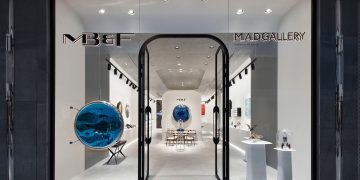
Founded in 2005, MB&F is the world’s first-ever horological concept laboratory. With almost 20 remarkable calibres forming the base of the critically acclaimed Horological and Legacy Machines, MB&F is continuing to follow Founder and Creative Director Maximilian Büsser’s vision of creating 3-D kinetic art by deconstructing traditional watchmaking.

After 15 years managing prestigious watch brands, Maximilian Büsser resigned from his Managing Director position at Harry Winston in 2005 to create MB&F – Maximilian Büsser & Friends. MB&F is an artistic and micro-engineering laboratory dedicated to designing and crafting small series of radical concept watches by bringing together talented horological professionals that Büsser both respects and enjoys working with.
In 2007, MB&F unveiled its first Horological Machine, HM1. HM1’s sculptured, three-dimensional case and beautifully finished engine (movement) set the standard for the idiosyncratic Horological Machines that have followed – all Machines that tell the time, rather than Machines to tell the time. The Horological Machines have explored space (HM2, HM3, HM6), the sky (HM4, HM9), the road (HM5, HMX, HM8) and the animal kingdom (HM7, HM10).

In 2011, MB&F launched its round-cased Legacy Machine collection. These more classical pieces – classical for MB&F, that is – pay tribute to nineteenth-century watchmaking excellence by reinterpreting complications from the great horological innovators of yesteryear to create contemporary objets d’art. LM1 and LM2 were followed by LM101, the first MB&F Machine to feature a movement developed entirely in-house. LM Perpetual, LM Split Escapement and LM Thunderdome broadened the collection further. 2019 marked a turning point with the creation of the first MB&F Machine dedicated to women: LM FlyingT; and MB&F celebrated 10 years of Legacy Machines in 2021 with the LMX. MB&F generally alternates between launching contemporary, resolutely unconventional Horological Machines and historically inspired Legacy Machines.
As the F stands for Friends, it was only natural for MB&F to develop collaborations with artists, watchmakers, designers and manufacturers they admire.

This brought about two new categories: Performance Art and Co-creations. While Performance Art pieces are MB&F machines revisited by external creative talent, Co-creations are not wristwatches but other types of machines, engineered and crafted by unique Swiss Manufactures from MB&F ideas and designs. Many of these Co-creations, such as the clocks created with L’Epée 1839, tell the time while collaborations with Reuge and Caran d’Ache generated other forms of mechanical art.
To give all these machines an appropriate platform, Büsser had the idea of placing them in an art gallery alongside various forms of mechanical art created by other artists, rather than in a traditional storefront. This brought about the creation of the first MB&F M.A.D.Gallery (M.A.D. stands for Mechanical Art Devices) in Geneva, which would later be followed by M.A.D.Galleries in Taipei, Dubai and Hong Kong.
There have been distinguished accolades reminding us of the innovative nature of MB&F’s journey so far. ‘To name a few, there have been no less than 7 awards from the famous Grand Prix d’Horlogerie de Genève: in 2021, MB&F received two prizes: one for LMX as the Best Men’s Complication and one for the LM SE Eddy Jaquet ‘Around The World in Eighty Days’ in the ‘Artistic Crafts’ category, in 2019, the prize for Best Ladies Complication went to the LM FlyingT, in 2016, LM Perpetual won the Best Calendar Watch award; in 2012, Legacy Machine No.1 was awarded both the Public Prize (voted for by horology fans) and the Best Men’s Watch Prize (voted for by the professional jury). In 2010, MB&F won Best Concept and Design Watch for the HM4 Thunderbolt. In 2015 MB&F received a Red Dot: Best of the Best award – the top prize at the international Red Dot Awards – for the HM6 Space Pirate.
MB&F – MILESTONES

2021: MB&F celebrates the Legacy Machine collection’s 10th anniversary with LMX, revisiting and accentuating the most striking features of the original LM1 – including a rotating, hemispherical power reserve indicator. The collaboration with clock maker L’Epée 1839 continues, with a 14th table clock called “Orb”.
2020: Launch of the eleventh Horological Machine, the HM10 Bulldog. A few months later, a two-way collaboration with fellow independent brand H. Moser & Cie, materialised by two timepieces: the LM101 MB&F x H. Moser and the Endeavour Cylindrical Tourbillon H. Moser x MB&F. Towards the end of the year, the LM Perpetual gains a new level of liberation with the LM Perpetual EVO, offering additional wearing comfort and robustness.
2019: MB&F launches for SIHH a new co-creation with l’Epée: MEDUSA. This year marks also a turning point with the creation of the first MB&F Machine dedicated to women: LM FlyingT. Last but not least, MB&F presents the world’s fastest triple-axis tourbillon: LM Thunderdome.
2018: MB&F begins the year with the unveiling of the second Performance Art piece in partnership with Stepan Sarpaneva: MOONMACHINE 2. This is followed by the HM9 ‘Flow’ as well as the opening of a new M.A.D Gallery in Hong Kong.
2017: MB&F plunges into the water at the SIHH with Horological Machine n°7 Aquapod. The Legacy Machine Split Escapement is launched in October.
2016: MB&F is invited to join the prestigious SIHH watch fair in Geneva. Melchior’s little brother is born: ‘Sherman’ is presented at SIHH. Balthazar joins the robot-clock line-up a few months later. In Dubai, a third MB&F M.A.D.Gallery opens its doors in January. Caran d’Ache and MB&F present the Astrograph pen, and HM8 Can-Am is launched in October.
2015: MB&F celebrates 10 years by launching anniversary pieces: HMX, the ‘Melchior’ table clock created with L’Epée 1839 and MusicMachine 3. Additionally, MB&F and watchmaker Stephen McDonnell reinvent the perpetual calendar complication with the LM Perpetual.
2014: Two new Machines: HM6 Space Pirate and Legacy Machine 101, which includes MB&F’s first in-house conceived calibre. Opening of a second M.A.D.Gallery in Taipei, Taiwan.
2013: The second Legacy Machine (LM2) comes to life. The HM3 is re-engineered as the HM3 ‘MegaWind. Also in 2013, the first co-creation between MB&F and music box manufacturer REUGE: MusicMachine 1 starts a trilogy of music boxes with spaceship-like designs.
2012: Launch of HM5, inspired by iconic 70’s supercars – back “On the Road Again”, 40 years later.

2011: Legacy Machine N°1 marks the beginning of a new line: the Legacy Machines are a tribute to 19th century watchmaking. The same year, the opening of the first MB&F M.A.D.Gallery in Geneva takes place, “where both horological machines and Mechanical Art Devices reign supreme”.
2010: Winner of the Grand Prix d’Horlogerie de Genève (GPHG), the HM4 Thunderbolt is MB&F’s most radical piece to date. Two variations of the HM3 are also released: the HM3 ‘Frog’, and the JLWRYMACHINE created with jewellery house Boucheron.
2009: Launch of the iconic HM3 series with the Horological Machine n°3 ‘Sidewinder’ and ‘Starcruiser’.
2008: Horological Machine No2 revolutionises the world of haute horlogerie with its distinctive shape and modular construction.
2007: MB&F unveils its first Horological Machine, HM1.
2006: While developing his first Machine, Max travels around the world to convince his future retail partners to join him in his adventure.
2005: After decades of conforming to the rules of corporate watchmaking, Maximilian Büsser breaks the chains and starts a rebellion called MB&F.



